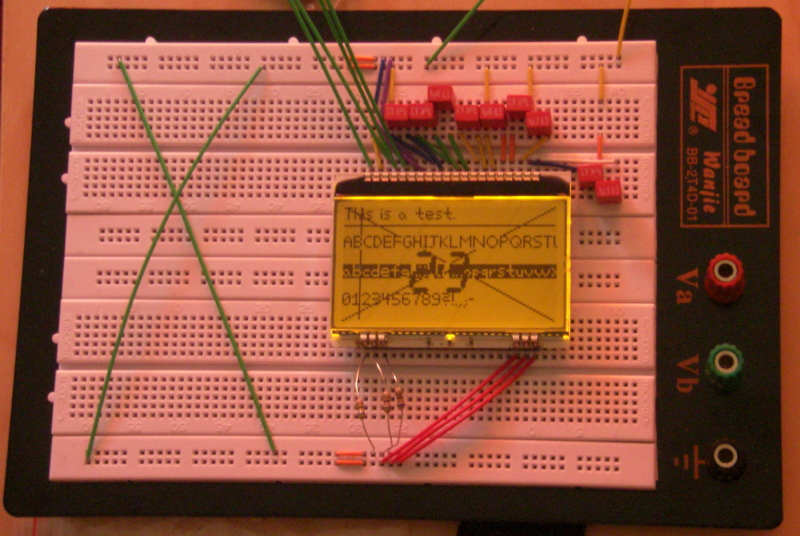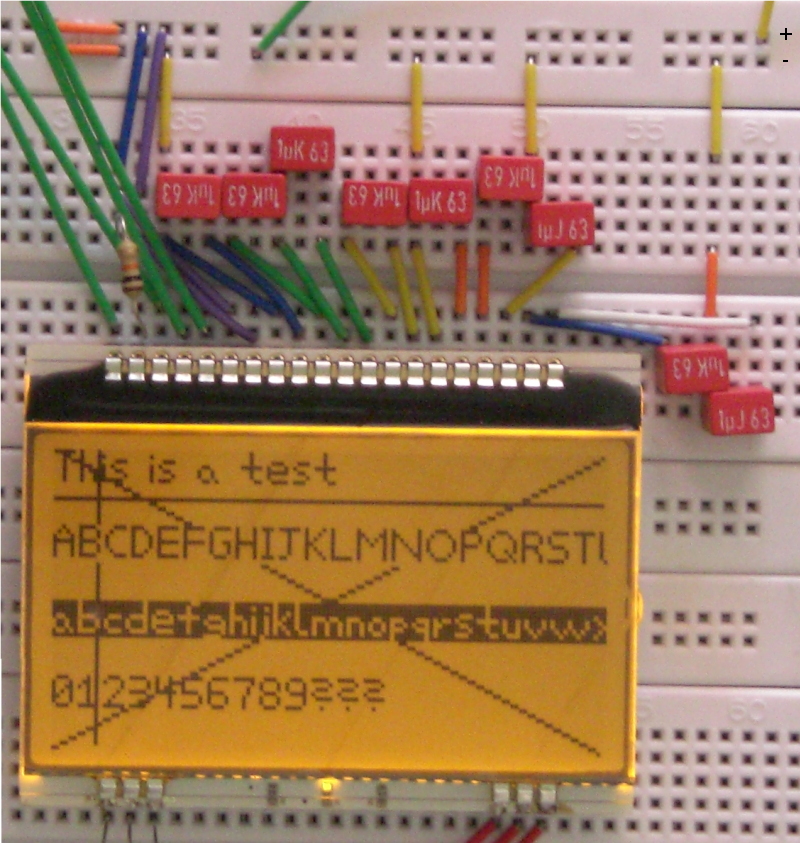| LCD Tests with an EA DOGL module |
Created: 13.04.2009 20:16 |
As part of a bigger project to (hopefully) build a better bicycle speedometer
one day, I played around with some graphical LCD display, the EA (Electronics
Assembly) DOG large 128x64. This display has the advantage that it has pins
in a 2.54 millimeter grid that can just be soldered onto a printed circuit
board (or even a perfboard) or put into some IC socket. Apart from this really
easy handling, it can also run with only one 3.0/3.3 supply voltage, and it
is available in many different color versions that can be combined with just
as many backlight colors. The backlight is actually a seperate part that just
gets mounted below the display. But enough with the commercial.
I got the DOGL128W-6, which is black on a white background
(FSTN pos. transflective), and an LED68x51-A amber backlight.
These parts were put onto a breadboard and connected to an Atmel AVR
microcontroller. I then started to write a software library for controlling
the display - from scratch. Though (by now) there is some source code
available on the internet, I prefer to do things on my own.
This software is available for download at the end of this post. Note that
it is only a library with an useless little demo that does some output -
it does not do anything useful. But you can use the library in your own
projects - at your own risk. It is licensed under GPL version 2 and
compiles with avr-gcc / avr-libc.
The library offers the following features:
- works with EA DOGL 128, and should also work with every other display
based on the Sitronix ST7565R chip.
- variable width fonts.
- Fonts can be defined in simple text files
that get then run through some (included) perl script to generate
a space saving font definition that can be programmed into the
microcontroller flash.
- fonts currently have no real limit w.r.t. the width, but can
only be at most 8 pixels high.
- one simple variable width font is included
- Fonts can be inverted
- lines can be drawn
- Images can be drawn from data stored in the microcontroller flash
- A Perl script is provided to convert images in .png or .gif format
to something that can be put into the microcontroller flash.
- Transparency is supported (also by the converter)
[Download library source]
Below are two pictures from the setup. Note that the 10K Ohm resistor visible
in the second picture that connects to the !Reset pin and was intended as
an pullup had to be replaced by a normal wire - with an resistor,
the display would occasionally lock up under load. And the colors in the
first picture are wrong, they are caused by sunlight.


|
4 comments
Hallo,
ich bin auch gerade am basteln mit dem EA DOG 128 Display und dein Beispiel finde ich super. Leider bin ich nur ein Anfänger und mit einem Grafikdisplay hatte ich noch nie gearbeitet und deshalb ist es eine große Hilfe für mich ein Beispiel zu haben. Danke! |
| Bobo |
21.12.2009 14:33 |
Hi,
Nice post.
I found this post using google picture search.
Could you tell me the value of the three resistors in image 1 (for the backlight) |
| Fraggel |
20.01.2015 09:52 |
| I'm afraid I don't remember the value of the resistors I used in the picture. However, these are just for powering the backlight, and the backlight is made up of three standard LEDs that require I = 20 mA, so trivial to calculate using the usual formulas. IIRC the voltage drop of the Amber display was 2.1 Volts (but check datasheet), so at 3.3 Volts supply the smallest resistor you could theoretically use would be 60 Ohms. Everything smaller could destroy the backlight, everything larger would just make it a bit less bright. Better be safe than sorry unless you're sure you calculated everything correctly. |
| PoempelFox |
25.01.2015 10:10 |
Hi,
I home you still have this design. I did not find answer anywhere. Can I use this module with no any back-light. Just as its own.
I need very tiny LCD, while back-light makes it thick.
|
| Mike |
10.06.2016 13:14 |
write a new comment:
|

